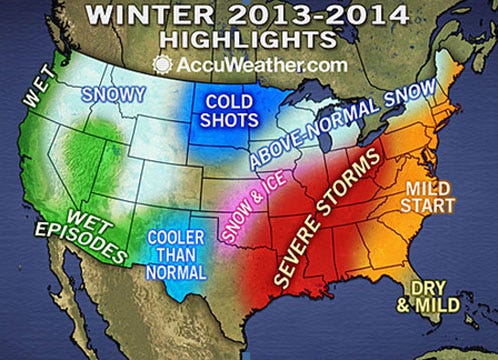
Global Weather Center – AccuWeather reports bank accounts will take another small hit this winter season as residents across the nation will see an increase in their heating bills. As AccuWeather's winter forecast predicts blankets of snow for the Rockies but an ease into winter for the East, expenditures for winter fuels are anticipated to rise, with the exception of heating oil costs. More than 90 percent of homes in the United States are expected to have higher bills for heating costs this winter season, from Oct. 1, 2013, to March 31, 2014, in comparison to last, according to the U.S. Energy Information Administration, or EIA. These bills could rise as early as this week, as the next three weeks will bring colder air to areas from the Ohio Valley to the Midwest. Farther west, prices could soon be jacked up as well due to higher energy usage.
"We will start to see more energy use in late October and November in areas centered from the Appalachians to the Midwest and in the northern Rockies," AccuWeather.com Lead Long-Range Forecaster Paul Pastelok said. However, with a mild start to winter predicted for the Northeast, residents in the East may initially save money on heating bills, followed by higher statements come March and April, Pastelok explains. Those living in the cities of Pittsburgh, Detroit, Charlotte, N.C., Atlanta, and Washington D.C., may save some money the first half of the season. Moving west though, locals living in areas from Denver to Salt Lake City and Boise will have higher energy costs due to a harsh winter season. A variety of factors contribute to the continued increase of fueling costs in recent years including the aging infrastructure of the power grid, the changes in how energy is produced and distributed. Fueling prices will range by location dependent upon local weather, energy efficiencies and the sheer size of the area being heated. A breakdown of the projected costs for each winter fuel ranging from natural gas to electricity can be found below. Natural Gas One-half of U.S. households use natural gas as their primary heating, according to the U.S. Census Bureau's 2012 American Community Survey. This winter the EIA expects a 13 percent increase for those using primarily natural gas to heat their homes, which approximates to an increase of roughly 80 dollars more than last winter. Those in the West can anticipate an inflation of up to 10 percent of costs and residents in the Northeast should prepare for up to a 15 percent rise in prices, according to the EIA Short Term Energy and Winter Fuels Outlook. "The Plains to the northern Rockies will be fairly cold this year, so there will be a high usage of natural gas in those areas," Pastelok said. With blasts of extreme cold and above-normal snow totals predicted for the northern Plains and abundant snow in the Rockies, natural gas prices in these areas could grow immensely due to high demands. Heating Oil "So far oil usage has been down because people have not needed to use their heat," Pastelok said. "However, oil may be used more often in the next four-week period due to colder weather from the Ohio Valley to the Midwest." Overall, however, the cost of heating oil will be down. Despite increases in expected consumption, the price for heating oil has declined and, as a result, consumers can bargain on spending about two percent less or roughly 46 dollars less this winter, according to the EIA's report. This comes as good news for those living in the Northeast where the EIA reports reliance on the oil is highest, as AccuWeather's winter forecast foresees January snowfall along the I-95 corridor and higher snow amounts compared to last year for Philadelphia. Propane Even though propane is no longer used as a primary heating source for many, those in the Midwest and Northeast that do use this energy source will encounter yet another increase in their bills. The EIA estimates that Midwestern residents will notice a significant price spike as propane costs rise nine percent from last winter, or roughly 120 dollars. With above-normal snow totals forecasted across the Midwest, residents using propane as their primary heating source should brace their bank accounts. However, in the Northeast, primary users of propane will see an even bigger jump in charges, as prices arise by 11 percent circa 206 dollars. Electricity Providing 63 percent of primary heating to the South, electricity this winter will cost locals two percent, or 18 dollars, more than last winter, reports the EIA. Although electricity prices are on the rise, citizens in the Southeast will experience well-above-normal temperatures to start the winter season and then possibly above-normal precipitation from heavy rain events along the central and western Gulf coasts in December and January. How to save money on your heating bill: 1. When leaving your home for a few hours or going to bed at night, lower the thermostat a few degrees. 2. Keep blinds, shades and draperies open during the day to allow sunshine to warm up the room. 3. Use exhaust fans in your bathroom and kitchen as little as possible. 4. Make sure the attic, exterior walls, floors, basements and crawl spaces are properly insulated. 5. Set the thermostat at the lowest comfortable temperature possible and dress in warm, layered clothing.
By Kristen Rodman, Staff Writer for AccuWeather.com
This article originally appeared on Santa Rosa Press Gazette: Accuweather reports say expect cooler temps this winter
